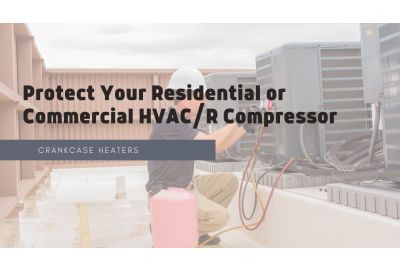It’s common practice for condensing units for air conditioning and refrigeration systems to be located outside the building or home for two reasons. First, the cooler outdoor ambient temperatures help reduce the amount of heat absorbed in the evaporator section, making the unit run more efficiently. Keeping the condensing unit outside the structure also reduces noise while it’s running. When the unit isn’t in operation, however, there is a risk of refrigerant migration and the potential for it to mix with the oil, which can lead to loss of efficiency and equipment damage. A crankcase heater for your HVAC/R compressor can eliminate these issues.
What Is Refrigerant Migration?
This is a technical term that describes what happens to the refrigerant inside your HVAC system if it’s shut down for an extended period. Refrigerant tends to move from higher pressure areas into lower pressure areas naturally. Since the crankcase has the lowest pressure, the refrigerant flows in that direction where it can condense inside the crankcase where it sinks below the oil during a long shut-down.
Upon startup, the HVAC/R system experiences an immediate drop in crankcase pressure, causing the oil and refrigerant to react violently inside the crankcase. A rich, pressurized foam seeps through the compressor, causing discharge valve damage, damage to mechanical parts, and potentially catastrophic damage to the unit. Installing a crankcase heater on your HVAC/R compressor can protect your system.
What Is a Compressor Crankcase Heater?
A crankcase heater is an electric resistance heater that’s designed to keep the refrigerant inside your HVAC system flowing. In most applications, a compressor crankcase heater is strapped or clamped to the crankcase bottom. However, a crankcase heater may also be inserted into a well inside the crankcase. Since they come in a variety of sizes, crankcase heaters for HVAC/R systems are ideal for commercial, industrial, and residential applications.
How Does a Compressor Crankcase Heater Work?
The operation of a crankcase heater is very simple. The sole purpose of the heater is to maintain a steady temperature, so the refrigerant doesn’t migrate when the unit is off. The crankcase heater produces a constant heat that maintains the proper viscosity of both the refrigerant and the oil inside the crankcase. This ensures that there is no migration or mixing of fluids and aids in smooth startup and efficient operation of the system.
When Is a Crankcase Heater a Good Idea?
Crankcase heaters are ideal for situations where the outside temperature drops below 40° to 50° and the system is shut down for extended periods. During cold spells, the crankcase heater brings the refrigerant and oil up to operating temperature before startup. This helps the HVAC system or chiller to startup more efficiently and protects the compressor from damage.
Is It Difficult to Install a Crankcase Heater on an HVAC/R Unit?
No, in fact, it is quite easy to wire a crankcase heater directly to the electrical box of the HVAC unit, Once installed, the crankcase heater will essentially be on standby awaiting a pause in system operations. Remember that crankcase heaters only operate when the system is turned off.
Which Crankcase Heater Should I Install?
Choosing a heater crankcase doesn’t have to be difficult. In fact, it’s quite easy when you shop with the Temperature Superstore. Our Backer Springfield crankcase heaters for HVAC/R compressors start at just $18.33 and they’re packed with quality. Check out the specs below:
- Material: Aluminum with SS Closure Strap
- Width: ½ inch (12.7 mm)
- Thickness: ¼ inch (6.4 mm)
- Max Surface Temperature: 300°F (150°C)
- Voltage: 240 to 480 VAC
- Wattage: 2 to 3.4 W/in (5 to 8.6 W/cm)
- Minimum Diameter/Circumference: 4.9/15.3 in (12.4/38.9 cm)
- Maximum Diameter/Circumference: 14.7/46.1 in (37.3/117 cm)
- Lead Wires: 18 GA; up to 48 in (1.2 m); XLPE Insulation; Black, Bare Wire End Terminations
- Lead Termination: Leads and Ground Exit on Each Side of Gap
- Clamp Style: Quick Release






